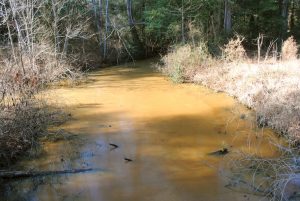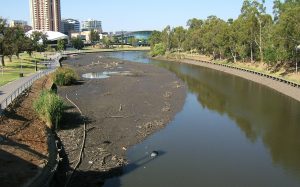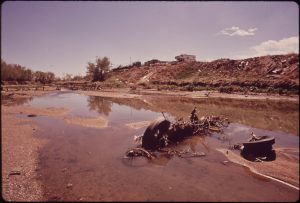Contaminated Rivers Rehabilitation by Dredging Soil Treatment and Water Purification
Integrated solution:
P2W is offering one-stop solutions for rivers.
- Dredging of the contaminated sludge from the river bad
- Handling it to the river banks for treatment.
- Establishing sludge cleaning processes
- Converting it to useful soil
- If required extracting precious material out of the sludge
- Treating the contaminating sources to the river and return clean water to the river.
To handle this integrated process P2W is collaborating with one the most advanced and experienced players in the world in the field of Dredging and Rivers Remediation for common projects. Both parties are engaged to deliver Maritime Core business
- Soil and sediment processing
- Soil and riverbed remediation (Brownfield development)
- Support Activities:
- Sampling, characterization & treatability studies
- Project Design studies: Integrated Approach
- Site investigation
- Available Techniques:
- Soil processing & dewatering
- Sediment processing & dewatering
- Solidification / Stabilization
- Minimizing contaminated sources at there start
- Mining and industrial tailing treatment
- Municipal sewage treatment
- Water treatment
Advance and Sustainable Solutions
Whether a large quantity of low to moderate level of contamination or higher level of contamination, P2W can provide you with an advance and sustainable!
- Confined disposal facilities (CDF’s);
For low contaminated sediments and large quantities (building with nature (6) ensures a match with the surroundings, e.g. bird islands, local vegetation’s)
- Separation and mechanical dewatering;
For the higher contaminated sediments or other logistic problems for these sediments with relative smaller quantities.
- Advanced environmental dredging technology combined with advanced sediment processing technology
- riverbed remediation projects in co-operation with one of the world leading subsidiaries and/or local partners
- Integrated project approach
(no technology push, but solution approach!)
River Treatment and Rehabilitation: An Eco-Friendly Wastewater Treatment System
Africa has been undergoing constant transformation since several decades now. With the unbeatable development in industrialization and commercialization in this region, the level of its air, water and land pollution has equally increased with good share of environmental damages than it could be thought earlier. Water pollution is mainly contamination of water bodies including the lakes, rivers, oceans, aquifers and groundwater et al. Primary reason of water pollution which takes place is that while pollutants are directly or indirectly discharged the chemicals from factories and or commercial establishments get into the water bodies without any adequate treatment to remove the harmful compounds.
Major Causes of Water Pollution
- Sewage
- Dumping
- Industrial Waste
- Oil Pollution
- Acid Rain
- Global Warming
- Eutrophication
River Treatment and Rehabilitation Help to Achieve Sustainable Solutions
Although the whole world has been suffering from one sort of water crises or the other today, the most affected continent is still Africa where this issue has literally plagued into monstrous one so much so that its masses are facing worst challenges ever. Over 358 million people in this continent lack the basic safe water. Its easy availability could ease safe drinking water problem. The first and foremost reason behind the creation of such draconian water crisis in Africa is its fast population increase. Second most important factor that further added its worries is unplanned industrialization over the decades. Its population has already doubled in the last 27 years. Ironically, they literally strive to get basic safe drinking water as per need.
Many mining and industrial plants are there which might prove a major backbone for this region’s economy but equally do they became curse for its masses. The biggest challenge is that through them biggest ever issue of water contamination has begun. The most suitable solution of such grave situation is to rely on the treatment of industrial wastewater from various mining as well as the commercial sectors existing in the region. Urgent plan for environmental safety and basic water resource management has therefore become mandatory today.
How to Treat Polluted Water
It has become the need of the hour to prevent the polluting of water bodies besides removing all sorts of existing contaminants. Through timely steps to start purifying the water bodies so as to make them fit for the desired use of drinkability, this region can offer safe water to its huge population with planned preparation.
Here are Some Proven Ways to Treat Polluted or Contaminated Water:
Industrial Treatment: Before making the water fit for re-use or disposal, it needs to be treated correctly in the water treatment plants. A technically advanced water treatment plant for industrial treatment can be helpful to use water for numerous purposes. Such plants reduce the amount of toxicity of waste and various harmful chemicals in water. Once treated, water becomes ready for various types of uses.
Denitrification: The process named Denitrification is mainly used to eliminate the nitrogen elements from sewage and municipal wastewater. Apart from preventing the leaching of nitrates in soil, it equally stops the groundwater from getting easily contaminated. This added benefit proves helpful for many purposes.
Ozone Waste Water Treatment: Considered one of the most popular methods of purifying contaminated water now, Ozone Waste Water Treatment has already gained ample popularity in the African region like it does in rest areas. In this method, pollutants and chemicals in water are broken down by an ozone generator. In addition to that, ozone oxidizes pollutants such as bacteria, molds and organic material from the contaminated water. This is how water is turned usable.
Septic Tanks: Septic tanks are the tanks which consist of one or more concrete or plastic tanks of between 4000 and 7500 liters. They are usually employed to treat the sewage waste at various places or locations instead of treating that in any plant or sewage system. This particular method is used at individual building levels thus anybody can take such initiatives for environmental safeguard on their personal capacity. In addition to that, sewages are usually separated into solid and liquid components and thus treated separately for better outcomes.
Why River Treatment and Rehabilitation Remain Mandatory?
It is known to the world that continents such as Africa and nearby regions still face the biggest challenge of scarcity of water even today. Researchers advise that river water can be used for various purposes in such places including human and animal drinkability solutions to home and public uses besides the most important one of agricultural use of water.
People in such regions cannot leave any option unexplored to making their water best usable. Through river treatment and for rehabilitation purposes, individual efforts can be done in such areas to create extra sources of usable water. It is the need of the hour in Africa and its surrounding regions which still lingers with water crisis.
If you are keen to learn more about the benefits of various water body treatments and rehabilitation for human use purposes, then start your online search now. You will definitely be able to find best solution. And, while doing so, you can also come to know the reality of water scarcity in the African region. You will definitely get a reply what makes it mandatory in this region to focus more on River Treatment and Rehabilitation. They are eco-friendly therefore offer proven solution for region’s sustainable growth.









